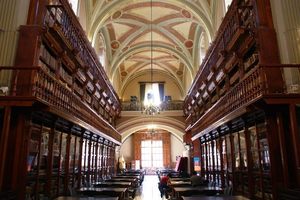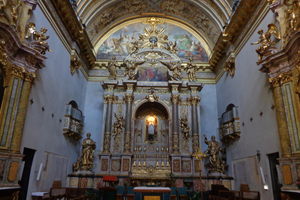Biblioteca Pública de la Universidad Michoacana in Morelia, Mexico

The construction of what was once the Convento de la Compañía de Jesús (Convent of the Society of Jesus) began in 1660 by decree from the Jesuit bishop Marcos Ramírez del Prado. It included the Jesuit college in addition to a church.
Following Mexico’s Reform Laws during the mid-19th-century, a majority of the country’s convents became the property of the state. Many were transformed into museums or other public, irreligious institutions. In the case of this former convent, the collegiate building would be transformed into the current cultural center known as Palacio Clavijero. Most of the temples joined to these convents, however, would continue to be used by the church for religious services.
The state of Michoacán presents several interesting exceptions to this tendency, particularly with the transformation of former church buildings into libraries. This is the case not only with the public library of the Universidad Michoacana in Morelia, but also the Gertrudis Bocanegra Public Library in nearby Pátzcuaro. In the case of the former Temple of the Society of Jesus, its transformation into a library was completed in 1930 as an initiative by then-governor of Michoacán, Lázaro Cárdenas del Río.
Cárdenas would become President of Mexico four years later, with significant support from the population of his native Michoacán, thanks to public works such as this library. In the early 1950s, further artworks were added to the library in a series of murals by three United States artists that included, R. Hansen, Hollis Howard Holbrook, and Sheldon C. Schoneberg, as well as Mexican artist Antonio Silva Díaz.
A total of six murals adorn the walls of the library, decorating the space between the shelves that hold nearly 23,000 volumes including seven incunables.





